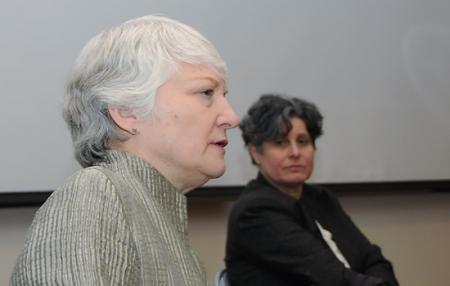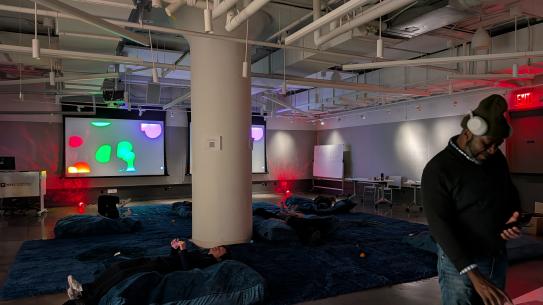Green Expectations: workshop explores the many shades of green building
 |
| Deborah Taylor (left) and Laurie Kerr (right) of NYC’s Mayor’s Office answer questions about the city’s efforts to cut its carbon emissions 30% by 2030. |
New York City’s carbon footprint is one quarter of one percent of the world’s total footprint. That’s the equivalent of a small country like Norway’s. Almost 80% of that air-polluting-, glacier-melting, extreme-weather-producing carbon footprint comes from NYC’s residential and commercial buildings.
To meet the city’s goal of cutting carbon emissions 30% by 2030 — part of what is known as PlaNYC — it will have to drastically reduce how much carbon its buildings produce. In fact, according to Laurie Kerr, Senior Policy Advisor at NYC Mayor's Office of Long-Term Planning and Sustainability, the city expects that 50% of PlaNYC’s reductions will come from “greening” existing and yet-to-be-built buildings.
Ms. Kerr was one of the speakers at Polytechnic Institute of NYU’s January 15 Green Buildings Workshop, the third in a series NYU-Poly has organized with Stevens Institute of Technology as part of their National Science Foundation-funded Environmental Entrepreneurship Initiative. The workshop brought together university and industry researchers, practitioners, policy makers, and investors of green building technologies, sustainability initiatives, developments, and startups.
A case study across the river
Ed Brzezowski thinks that buildings can be small power-plants that not only produce enough energy to sustain their own operational needs, but also produce surplus electrical energy that can be put into city grids. Some of the surplus can even be used to power tenants’ electric cars, as is the case at 31 Tannery in Branchburg, New Jersey, the nation’s first commercial net-zero electric building, which Mr. Brzezowski engineered.
“I’ve been waiting for 30 years for the world to catch up,” Mr. Brzezowski said of incorporating green technologies like solar panels and solar thermal systems into building design and construction. “The issue of energy comes and goes, but this time it’s not going away.”
Mr. Brzezowski’s equation for successful green building, as exemplified by 31 Tannery: energy efficiency + renewable energy + monitoring & visualization = sustainable, high-performance building.
Monitoring and visualization is one of the bigger gaps in current building technology. “Unlike a car, a building has no real-time display of how it’s working,” explained Mr. Brzezowski. “By the time the electric company sends the bill, it’s too late for a building manager to take action.”
Mr. Brzezowski’s company, Noveda Technologies, has developed software that can change that. Its web-based products, which resemble the at-a-glance design of a car dashboard, allow building managers to see how much energy their buildings are using — from electric to gas to solar. Other statistics, like the size of a building’s carbon footprint, have been displayed in the common areas of buildings like 31 Tannery. Mr. Brzezowsk says “it’s a real eye-opener” and an education for tenants and visitors.
Greening NYC’s construction code
“No place has systematically tried to attack existing buildings,” said Ms. Kerr of the city’s aggressive effort to green its construction code.
For nearly 40 years, NYC’s construction code remained largely unchanged until it overhauled it with international models in July 2007. According to Deborah Taylor, Buildings Department Chief Sustainability Officer, the international models weren’t expressly designed to be green, but do have green advantages. They include fee rebates for sustainable buildings, and a mandate that buildings have white or reflective roofs.
The Mayor’s Office has established a task force to up the green intensity of the 2007 code. Ms. Taylor gave an overview of the task force’s initial efforts, which include benchmarking how energy efficient the city’s buildings currently are, and retrofitting buildings to increase efficiency.
Bottom lines and the rise of megacities
Fifteen years ago, the dominating focus of environmental engineering was remediation, i.e., cleaning up the damaging pollutants we humans put into the environment. Now, as Kurt Becker, NYU-Poly Associate Provost for Research and Technology Initiatives, explained in his opening remarks, “the field of environmental engineering is focused on sustainable, green building for the economic good of the environment.”
In other words, fixing the harmful byproducts of commercial and residential development and infrastructure is far more costly than engineering such structures to have less negative impact on the environment from the outset.
31 Tannery, for example, actually makes money when the solar energy credits it earns from NJ State are calculated into its operational energy costs. And in New York City, it’s expected that it’ll take a mere 7.5 years for the city to be paid back in energy savings from its PlaNYC investments in energy efficient buildings and lighting and an improved power grid.
Making New York City greener, more sustainable, and ultimately more livable, is important not just to New Yorkers. “It’s important because in today’s globalized economy, the impact of a city is global, not just local,” says George Buglierro, NYU-Poly President Emeritus and Professor of Civil Engineering.
For the first time in history, more people live in urban areas than rural, a trend that is expected to continue. One of the workshop’s biggest takeaways was that that surge in urban population growth, primarily in the world’s 20+ megacities (cities with more than 10 million people), increases the urgency for green building technology, funding, and education.
About the Environmental Entrepreneurship Initiative
Polytechnic Institute of NYU and Stevens Institute of Technology established the Environmental Entrepreneurship Initiative after receiving a joint 2-year, $570k grant from the National Science Foundation’s (NSF) Partnership for Innovation Program in January 2007. The Initiative fosters rapid marketplace realization of environmental innovations that are capable of being adopted by existing companies, or can serve as the basis for creating new ventures. Kurt H. Becker, Associate Provost for Research and Technology Initiatives, and Bruce Niswander, Director of Technology Transfer, IP Commercialization and Entrepreneuring, serve as the grant’s Co-Principal Investigators for NYU-Poly.



